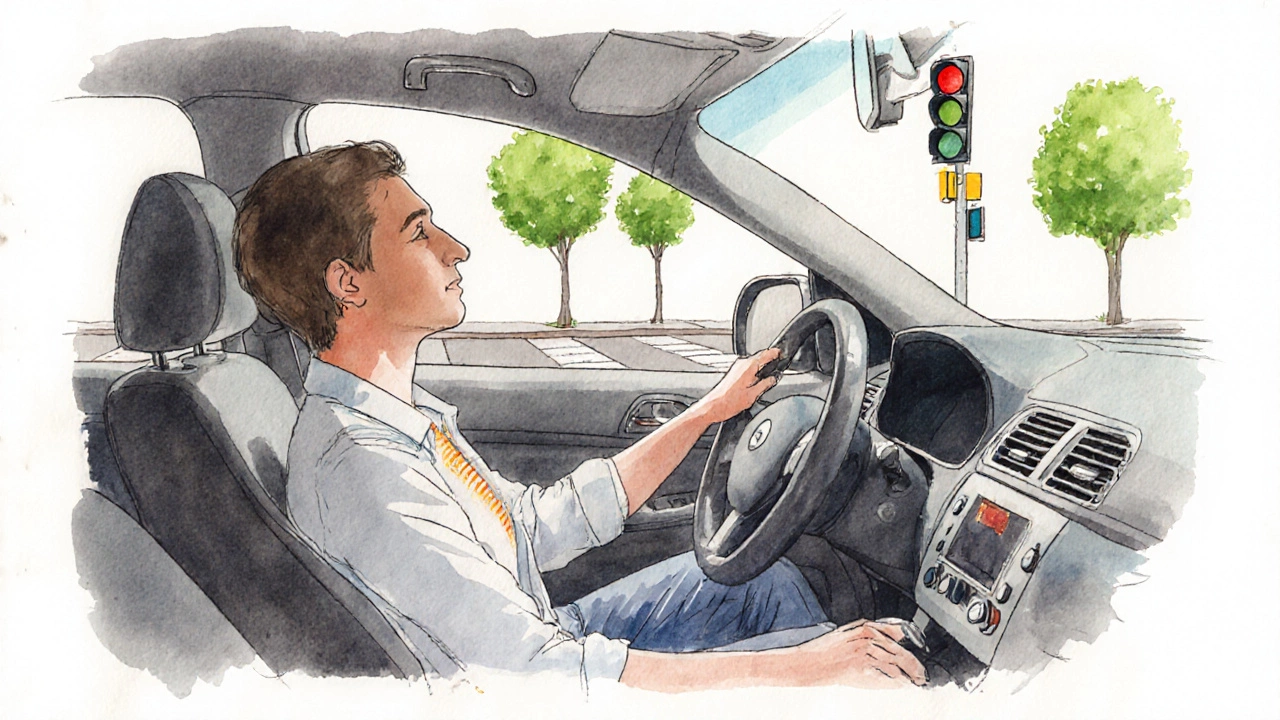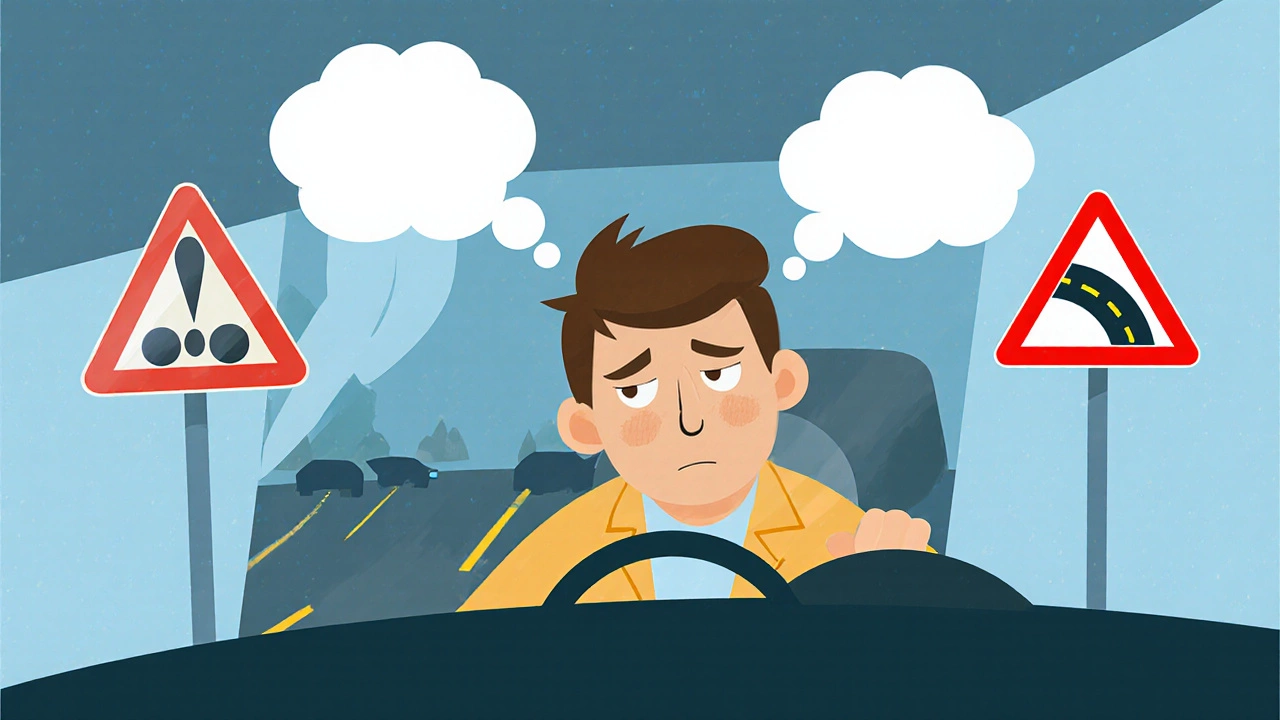Pre-Drive Anxiety Checklist Builder
Build Your Personalized Checklist
Your Personalized Checklist
Your pre-drive checklist is ready. Remember: One thought at a time.
Box Breathing Exercise
Inhale: 4s | Hold: 4s | Exhale: 4s | Hold: 4s
If you want to stop overthinking while driving, try these proven steps that keep your mind clear and your hands steady.
What "overthinking while driving" really is
Overthinking while driving is a cognitive pattern where a driver repeatedly doubts decisions, scans excessively, or rehearses worst‑case scenarios, which can cause stress and slower reaction times. It often shows up as "what if I missed that sign?" or "did I choose the right lane?" during a normal commute. The habit isn’t a sign of bad skills; it’s a mental overload that anyone can develop, especially new learners or people who have taken a crash‑avoidance course.
Why the brain overload happens behind the wheel
Driving demands visual, auditory, and motor processing simultaneously. When you add self‑criticism, the brain’s Cognitive Load spikes. Research from the University of Auckland (2023) showed that drivers with high anxiety performed 12% slower on hazard‑perception tests. The extra mental chatter competes with the vital information you need to notice-traffic lights, pedestrians, and the speed of surrounding vehicles.
Key mental habits that fuel the cycle
- Constantly replaying a recent mistake (e.g., "I stalled at the hill").
- Scanning too far ahead and losing focus on the immediate lane.
- Relying on “what‑if” scenarios instead of staying present.
Each habit adds layers of Anxiety that keep the mind stuck in a loop. The good news? You can break the loop with concrete, low‑effort techniques.

Simple mental tricks to calm the mind
- Box breathing: Inhale for 4 seconds, hold 4, exhale 4, hold 4. Do it at a stop sign or while waiting at a traffic light.
- Grounding cue: Touch the steering wheel, feel the seat, name three things you see outside. This anchors attention to the present.
- One‑thought rule: Allow only one thought about the road at a time-e.g., "check blind spot now"-and let the rest fade.
These practices are rooted in Mindfulness training, which has been shown to reduce driving‑related stress by up to 30% in a 2022 clinical trial.
Pre‑drive checklist to limit mental clutter
Before you even turn the key, run through a short list. The checklist works like a mental warm‑up, similar to a Driving Instructor’s routine before a lesson.
| Step | Action | Why it helps |
|---|---|---|
| 1 | Adjust seat and mirrors | Physical comfort reduces distraction |
| 2 | Set the climate control | Avoid fiddling while moving |
| 3 | Take three slow breaths | Triggers the box‑breathing switch |
| 4 | Recite a single driving goal (e.g., "stay in lane for the next 5 minutes") | Focuses attention on one task |
| 5 | Toggle a reminder on phone: "check blind spot now" | External cue prevents mental drift |

Practice strategies during lessons
Applying the techniques while you’re still on a lesson gives you safe feedback. Try these ideas with your instructor:
- Ask for a “quiet‑drive” segment where you focus only on breathing and grounding.
- Request a short debrief after each maneuver to note any overthinking moments.
- Use a simple scorecard: 1=completely focused, 5=mind wandering. Track progress over weeks.
When you see improvement, you’ll notice a boost in Defensive Driving skills because you’re less likely to miss peripheral cues.
Building long‑term confidence
Consistent habits turn a temporary fix into a lasting skill. Here are three pillars:
- Routine: Perform the pre‑drive checklist every time. Muscle memory takes over, freeing mental space.
- Positive self‑talk: Replace "I’m going to mess up" with "I’m prepared and in control". Studies on driver confidence show a 22% reduction in error rates after six weeks of positive framing.
- Gradual exposure: Start on quiet streets, then add light traffic, then busy highways. Each step reinforces the belief that you can handle complexity without overthinking.

Common pitfalls and how to sidestep them
Even with the best plan, some traps creep in. Spot them early:
- Multitasking with the phone: Even a quick glance spikes cognitive load. Keep it out of sight.
- Relying on “just a feeling”: Feelings can be biased. Use the grounding cue to verify, not guess.
- Skipping the checklist when rushed: The checklist only takes 30 seconds and prevents larger errors later.
Remember, Road Safety isn’t just about external rules; it’s also about internal mental hygiene.
Frequently Asked Questions
Why do I overthink only in heavy traffic?
Heavy traffic raises the number of visual and auditory inputs, which inflates Cognitive Load. The brain defaults to safety‑first loops, causing you to replay possible mistakes. Using grounding cues and the pre‑drive checklist helps keep the mind anchored despite the chaos.
Can mindfulness really improve my driving performance?
Yes. A 2022 study from the New Zealand Institute of Transport found that drivers who practiced two minutes of mindfulness before each trip reduced lane‑deviation incidents by 18% and reported lower anxiety levels.
How often should I repeat the breathing exercise?
At every stop-traffic lights, stop signs, or a brief pause in congestion. A quick 30‑second box breath re‑sets your nervous system and prevents the spiral of over‑analysis.
Is it okay to use a phone reminder for blind‑spot checks?
Yes, as long as the reminder is set before you start moving. It acts as an external cue, freeing your mind from having to remember the step internally.
What if my anxiety spikes during a long highway drive?
Pull over safely at the next exit or rest area. Perform three rounds of box breathing, then replay your grounding cue. Once calm, restart with a refreshed focus on the pre‑drive checklist.

